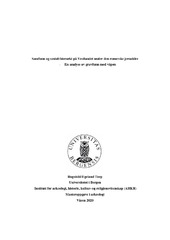Samfunn og sosialt hierarki på Vestlandet under den romerske jernalder - En analyse av gravfunn med våpen
Master thesis
Permanent lenke
https://hdl.handle.net/1956/21817Utgivelsesdato
2020-04-04Metadata
Vis full innførselSammendrag
Weapons can be found among the grave goods in Norway during the Roman Iron Age (0-400 AD). These may be a source of information regarding the deceased. Weapons as grave goods may have been an expression of the social position of the person being buried, either as a warrior and/or social status. It is also possible that weapons reflect the ritual and religious aspects surrounding burial. The aim of this study is to gain an understanding of the social conditions in Western Norway during the Roman period based on 25 weapon graves located in in Hordaland, Sogn og Fjordane and at Sunnmøre in Møre og Romsdal. As a way of doing this, I have studied the combination of weapons and their geographical location. The results indicate that only a few privileged members of the society in Western Norway were granted weapon graves, as the number of graves is quite low. Altogether these findings illustrate a stratified society characterised by a social hierarchy. This is further supported by the variation in the weapons found, as well as in the remaining grave goods. Most weapons burials from the study area containing status-indicating objects are located near either Reiersen's (2017) elite centers or Ringstad's (1986) gravemounds centers.
